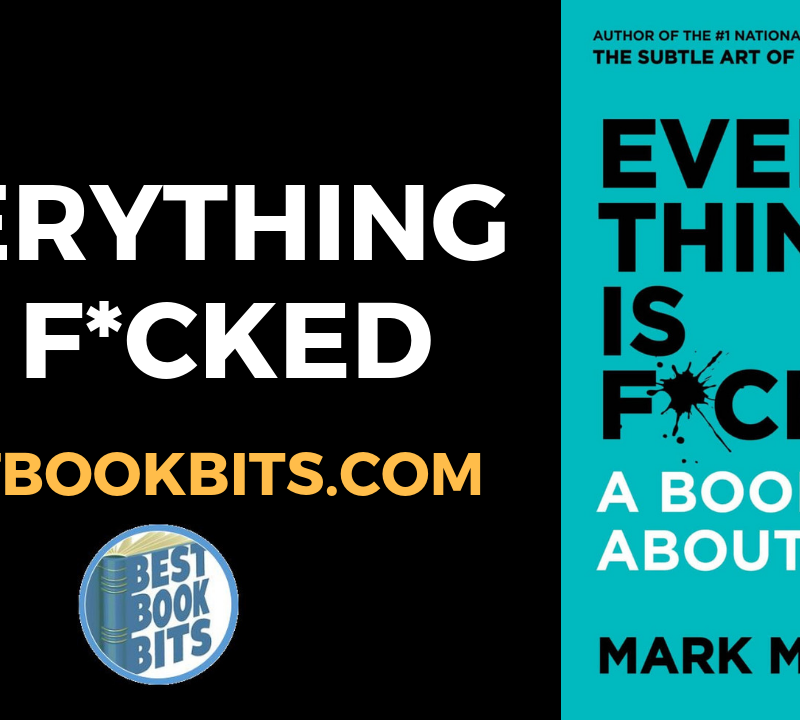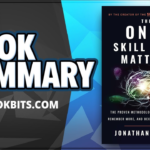< DOWNLOAD THIS SUMMARY IN PDF HERE >
< FOLLOW US HERE > |YouTube |Spotify | Instagram | Facebook | Newsletter | Website
Embrace the suck: The Navy Seal Way to an Extraordinary Life by Brent Gleeson
Get into the Navy SEAL mindset with this raw, brutally honest, in-your-face self-help guide that will teach you how to thrive on adversity.
During the brutal crucible of Navy SEAL training, instructors often tell students to “embrace the suck.” This phrase conveys the one lesson that is vital for any SEAL hopeful to learn: lean into the suffering and get comfortable being very uncomfortable. In this powerful, no-nonsense guide, Navy SEAL combat veteran turned leadership expert Brent Gleeson teaches you how to transform every area of your life–the Navy SEAL way. Can anyone develop this level of resilience? Gleeson breaks it down to a Challenge-Commitment-Control mindset. He reveals how resilient people view difficulties as a Challenge, where obstacles and failures are opportunities for growth. Next, they have a strong emotional Commitment to their goals and are not easily distracted or deterred. Finally, resilient people focus their energy on the things within their Control, rather than fixating on factors they can’t impact. Embrace the Suck provides an actionable roadmap that empowers you to expand your comfort zone to live a more fulfilling, purpose-driven life. Through candid storytelling, behavioral science research, and plenty of self-deprecating humor, Gleeson shows you how to use pain as a pathway, reassess your values, remove temptation, build discipline, suffer with purpose, fail successfully, transform your mind, and achieve more of the goals you set
Pain is a pathway.
Life will eventually knock you hard on your a**. Accepting that fact is a stepping-stone to growth. Just expect pain. Constantly trying to avoid hardship and pain will only hold you back. Each experience, each moment that you have is precious. Challenge every moment to make the best out of even the worst circumstances. You may well be amazed at the power, wisdom and strength you gain in the process.
“You might be wondering this and telling me to go f*** myself, that I haven’t been through the kind of suffering you’ve endured. And that may very well be true. My intention with this book is not to appear that I know it all or have experienced all the hardships life has to suffer. I’m simply providing a tool to use in your own way while navigating darkness and uncertainty.” – Brent Glesson
The point is we all have our own journeys. We all have to embrace the suck along the way.
If you ain’t falling, you ain’t trying.
Failure is usually a fairly demoralizing and upsetting experience. It can alter your perception and make you believe things that simply aren’t true. Unless you learn to respond to failure in psychologically adaptive ways, it can paralyze you and ultimately keep you from moving forward. To deal with inevitable setbacks, Embrace the Suck has eight failure realities that you must understand:
Reality 1: Failure makes the same goal seem less attainable.
In one study of a special operations sniper school, instructors had their students fire at targets from the same distance on an unmarked range. They then had the students estimate the distance to the targets. Students who scored lower believed the targets to be significantly farther out than students who scored the highest. Failure distorts perception if you allow it to. The good news is there are ways to avoid it.
Reality 2: Failure alters your perception of your abilities.
As much as failure can distort your perception of goals, it can also alter your assumptions about ability. Students who quit BUD/S or fail the selection process fall into deep depression -sometimes even become suicidal. Failure can make us doubt our skills, intelligence and capabilities. Simply acknowledging this is the first step to self-correction.
Reality 3: Failure can make you feel helpless.
This is a mental defense mechanism. When we fail, the brain sends signals making us feel temporarily helpless. It’s an emotional wound so to speak. Like when a toddler touches a hot stove and the brain says not to do that again. The same applies with failure. When we allow ourselves to be convinced we’re helpless, we successfully avoid future failures. But that’s actually what makes you a failure – when you listen to the voices and rob yourself of future success.
Reality 4: A failure experience can cause a fear of failure complex.
People also tend to avoid success as much as they try to avoid failure. The two usually go hand in hand. Success rarely, if ever, comes without experiencing some failure along the way. This is why success is very uncomfortable. So rather than working on improving their abilities and skills, people head back to home base – their own cozy little comfort zone.
Reality 5: Fear of failure often leads to unconscious self-sabotaging.
Like the college student who decides to stay out drinking until 2AM before a big job interview he knows he’ll bomb. Or the young kid who doesn’t pick up a sport as naturally as her peers, so she tells her parents she hates it and wants to quit. These kinds of self-sabotaging behaviors guarantee future failure. The best accomplishments in life usually reside on the other side of fear.
< DOWNLOAD THIS SUMMARY IN PDF HERE >
< FOLLOW US HERE > |YouTube |Spotify | Instagram | Facebook | Newsletter | Website
Reality 6: The pressure to succeed can cause choking.
Choking at those critical game-winning moments, blanking out during the test after weeks of studying, leaving out the most critical talking points in your presentation are usually a result of over-thinking. Proper preparation, not over-thinking, is the bedrock of pulling off your best performance in critical moments.
Reality 7: Willpower is like a muscle. Use it or lose it.
Like muscles that become fatigued, mental willpower can become overworked and undernourished. Soldiers participating in sustained combat experience battle fatigue, which causes clouded thinking, lack of ability to control emotion, confusion and even depression. So when you feel your willpower fading away, take a good rest and space to revisit your motivations. Just don’t take it too long.
Reality 8: The healthiest psychological response to failure is focusing on what you can control.
This ability is fundamental to building resilience. Failure can result in us focusing primarily on the cause of our current adversity. We look backward instead of forward. We focus on elements we have no control over as opposed to developing an action plan – leveraging what’s in our control.
Do something that sucks, everyday.
Stress and anxiety can be great tools if you know how to use them and choose to use them. With all the media and medical attention on the negative impacts of stress, it’s easy to conclude it’s irredeemably bad, something to be avoided at all costs. This applies to both physical and emotional stress and anxiety.
Think about a time when you experienced substantial and professional growth or a time when you performed at your highest level. Say finishing a race, building a business or saving it, landing your dream job, raising a child. Chances are all those moments shaped your growth and defined who you are today.
Drawing on their work and research with business executives, Navy SEALs, students and professional athletes, psychologist Alia Crum and Thomas Crum developed a three-step model for responding to pressure and harnessing the creative power of stress. The model looks like this:
- See it.
- Own it.
- Use it.
Step 1: See the stress.
We typically only stress about things we care about. When we can start labelling that we care about, the solutions for alleviating stress become far more apparent. For example, on the days the author is feeling stressed out, he asks his wife “why the hell am I so stressed?” The intention is not necessarily for her to answer his question. It’s a method for him to break down the possible root causes and identify them. Usually it’s not what he thinks it is and totally unrelated to what’s actually consuming his thought.
Step 2: Own the stress.
Owning the realization that we stress the things we care about unleashes the positive aggression within us. Deep down, we know things that really matter in life don’t come easy.
In SEAL training, the instructor cadre design situations that are exponentially more stressful and dynamic than actual combat so that the team learns to center themselves in the most chaotic circumstances. When the stress of that seems unbearable, the trainees can own it by knowing it’s what they’ve chosen to do, to win in any situation.
Step 3: Use the stress.
Though it often feels like it, the body’s stress response was not designed to kill us. In fact, the evolutionary goal of the stress is to help boost the body and mind into enhanced functioning, to help us grow and meet the increasing demands we face. Elite athletes and navy SEALs know this. If they were to become the fastest, strongest and toughest man alive in the world, pain, stress and suffering would be a regular gateway.
And while the stress response can sometimes have adverse effects, in many cases, stress hormones do in fact induce growth and release chemicals into the body that rebuild cells, synthesize proteins and enhance immunity, leaving the body even stronger and healthier than before.
We’re all going to die, so get off your a** and execute.
We’re all going to sing our death song, some day. What matters is what we do at this moment in time. What mark do we want to leave on our friends, families, communities and the world at large? What do we absolutely not want to regret on the day we sing our songs? Will we reflect on our lives and realize we didn’t take many risks and stayed safely in our village? Or will we know that we left everything we have on the battlefield of life?
The answer depends on whether or not we choose to lean into the suffering and get comfortable being uncomfortable. The choice is ours.
< DOWNLOAD THIS SUMMARY IN PDF HERE >
< FOLLOW US HERE > |YouTube |Spotify | Instagram | Facebook | Newsletter | Website














